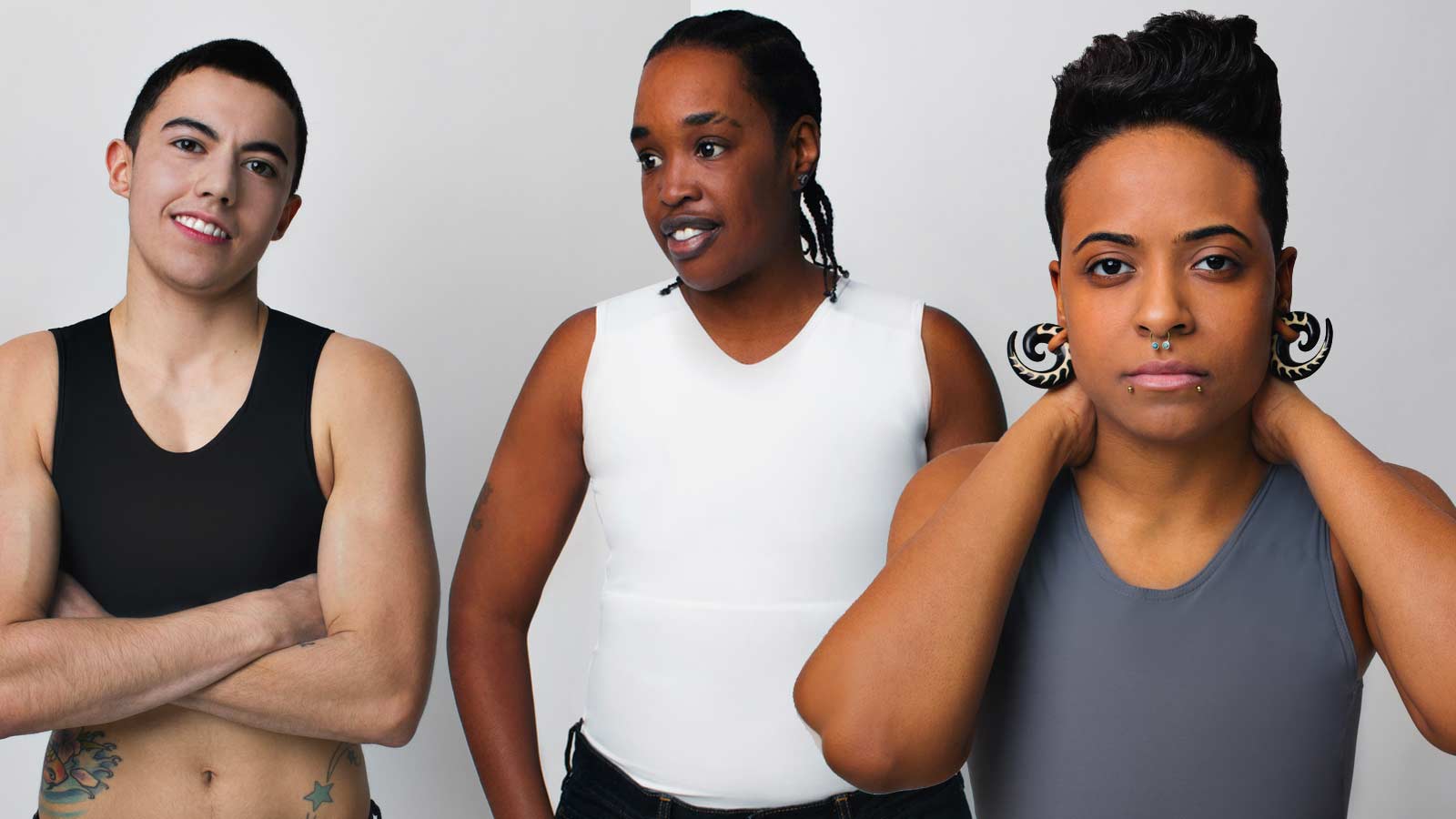Binding Safely for Your Body: Tips for All Body Types and Sizes

For many of us, a flat chest affirms our identities or helps us to be read correctly in public. If you choose to bind your chest, it's important you do it in a way that is as safe and comfortable as possible, and that means you'll need to listen to your body's unique needs.
Before you read below, be sure you're familiar with the general best practices to bind safely. And if you're looking to purchase a binder, we recommend our friends at gc2b, a trans-owned and operated company.
Everybody is different, and every body is different. Because those who bind are so diverse — every shape, every gender, every age — this is not an exhaustive guide. For questions specific to your needs, we strongly recommend you consult your healthcare professional, if possible.
Binding for Bigger Chests/Plus-Sized Folks
Size appropriately
Don't try to squeeze into a binder that's not your size. Binders are supposed to compress, but they are sized for a reason: to compress the right amount. You deserve the best possible fit to ensure your safety and comfort, so be sure to consult your binder maker's sizing guide. (Many manufacturers go up to 5X, but if you need a larger size or prefer a custom fit, made-to-measure options are also available from various retailers. For custom sizing, we recommend our friends at Origami Customs.)
Getting your binder on
For many of us (but especially for us folks with larger chests) getting that binder on the first time is a challenge. You will probably have to step into it, pull your binder up around your waist, and then fit your arms through the holes and adjust. Many folks can't pull the binder on overhead unless it is gently-used or already stretched out from frequent wear.
Try a different technique
Some larger-chested folks recommend pushing their tissue towards their armpits, instead of letting the binder push your chest flat down in place. Some recommend pushing down-and-out, others up-and-out. You may have to adjust periodically throughout the day. Experiment to see what position works best with your body, both for looks and for comfort.
Binding technique for those with large chests (credit: Wilson Freeman)
You're your own worst critic
Don't judge your appearance by looking down. Look at yourself in the mirror (after all, that's how everyone else will see you!) to get the best idea of how you look. Your chest will be more apparent when you look down at it than you realize. Remember that cis men don't always have perfectly flat chests.
Never wear two binders at once
Some larger-chested folks have shared that they wear a binder over another binder or a sports bra. Don't do it: this practice you can really damage your ribs and lungs!
Give yourself extra breaks
Those of us with larger chests in general need to give our bodies more breaks — that means trying your best to only bind 6-8 hours at a time, and to never bind overnight while sleeping or while exercising. You should wear a binder as little as is possible for you. We commonly hear:
- "I am in school/work for X hours, plus a commute, plus everything else I have going on. How do I limit myself to only 6-8 hours?"
We get it. Busy schedules make it difficult, so what some folks do is find private moments – like a lunch break or driving in the car – to remove their binder. Others prioritize not binding on the weekends, to give their bodies extended rest. Or, you can get creative: if it's winter time and you're commuting while wearing a heavy jacket, you can put your binder on in the bathroom/locker room when you arrive to class or work. - "Mentally, it is impossible for me to get through the day without binding 24/7."
Binding is an awesome way to minimize dysphoria and help with passing, but you still have to be safe about it. Some folks recommend relying on other social cues to help pass and help alleviate dysphoria by affirming your identity in other ways: clothing/appearance and self-care go a long way.
Resources:
- Wilson Freeman on YouTube: Binding technique for large chests (video)
- Susan's Place: Binding for Large Chests
- FTM Forum Livejournal: Binding for Bigger Guys
- ComfyFat: Binding for Plus-Sized Babes
Binding for Smaller Chests
The same rules apply
Many of the tips aimed at folks with larger chests apply for everyone: listen to your body, give your body breaks, try to bind as little as you possibly can, never wear two binders at once, etc.
Size appropriately
Oftentimes, those of us with smaller chests are optimistic we can get our chests flat as a board, and we might be tempted to choose a binder size smaller than we typically wear. If you're a size Medium and you opt for that size Small, you'll only be putting extra pressure on your back and ribs, and you likely won't get any flatter. Each kind of binder has its own sizing (even from the same company, in some cases), so check the instructions for measurements when shopping around.
Consider a sports bra
A sports bra is designed to offer a decent level of compression without causing harm. For some of us, a great sports bra can be just as effective as a binder, plus it's often cheaper and easier to buy.
Resources:
- Buzzfeed: All The Questions You Had About Chest Binding, But Were Afraid To Ask
- Minus 18: Healthier And Safer Ways To Bind Your Chest
Binding when Differently-Bodied or with Medical Considerations
If you are differently bodied or have special needs concerning your health, it's especially important to consult a trusted medical expert before you bind your chest. Because binding garments put pressure on your chest, ribs, and internal organs, and can often restrict your movement, you should be extra cautious before you start using a chest compression shirt: give yourself extra breaks if you can and start with a looser garment at first.
Skin health
We've heard from folks who are prone to acne, eczema, or other skin conditions that they have seen worse symptoms, so when you take your binder off each night, check your skin and make sure it's breathing and healthy. You should not see redness or bleeding around where the edges of your binder touches; if you do, it's too tight on your skin. Plus, binding can be sweaty business: try to keep your binder and your skin as dry as possible to prevent problems, especially in the summer heat.
Breathing
Some folks with asthma or other breathing conditions have noticed worsening symptoms: if you have difficulty breathing, take it off immediately. You can try to use an undershirt or sports bra to give you some security and light compression without restricting your lungs. Always consult a medical professional if you have any concerns or questions.
Mobility
For those of us with mobility issues, there are styles of binders with zippers, velcro, or clasps on the front that may be easier to maneuver over single-piece options you have to step into or pull over your head.
Binder style also makes a difference: tri-top binders, for example, end midway on your torso, so some folks report back pain, slouching, or aches as a result. On the other hand, full-length binders often have compression on your whole core and stomach, which can be uncomfortable for other folks. With so many styles and designs to choose from, the right binder for you is out there.
Resources:
The information on this page is for general education only. It is not medical advice, legal advice, or professional advice. For questions or help with your specific situation, please talk to a licensed doctor, lawyer, or another qualified expert.

Written by Point of Pride
Point of Pride provides financial aid and direct support to trans folks in need of health and wellness care.


